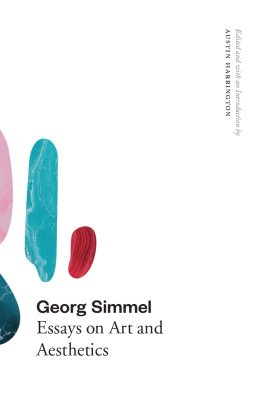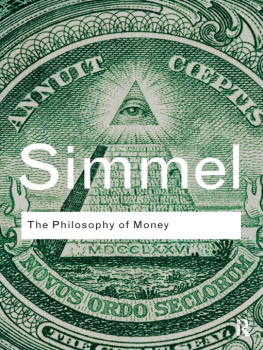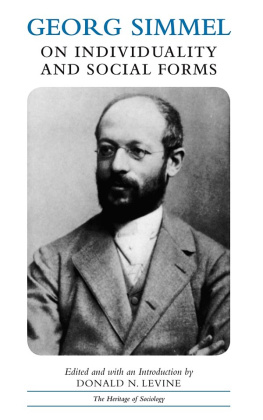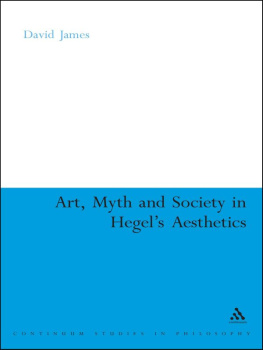Georg Simmel - Essays on Art and Aesthetics
Here you can read online Georg Simmel - Essays on Art and Aesthetics full text of the book (entire story) in english for free. Download pdf and epub, get meaning, cover and reviews about this ebook. year: 2020, publisher: University of Chicago Press, genre: Science. Description of the work, (preface) as well as reviews are available. Best literature library LitArk.com created for fans of good reading and offers a wide selection of genres:
Romance novel
Science fiction
Adventure
Detective
Science
History
Home and family
Prose
Art
Politics
Computer
Non-fiction
Religion
Business
Children
Humor
Choose a favorite category and find really read worthwhile books. Enjoy immersion in the world of imagination, feel the emotions of the characters or learn something new for yourself, make an fascinating discovery.
- Book:Essays on Art and Aesthetics
- Author:
- Publisher:University of Chicago Press
- Genre:
- Year:2020
- Rating:3 / 5
- Favourites:Add to favourites
- Your mark:
- 60
- 1
- 2
- 3
- 4
- 5
Essays on Art and Aesthetics: summary, description and annotation
We offer to read an annotation, description, summary or preface (depends on what the author of the book "Essays on Art and Aesthetics" wrote himself). If you haven't found the necessary information about the book — write in the comments, we will try to find it.
Essays on Art and Aesthetics — read online for free the complete book (whole text) full work
Below is the text of the book, divided by pages. System saving the place of the last page read, allows you to conveniently read the book "Essays on Art and Aesthetics" online for free, without having to search again every time where you left off. Put a bookmark, and you can go to the page where you finished reading at any time.
Font size:
Interval:
Bookmark:
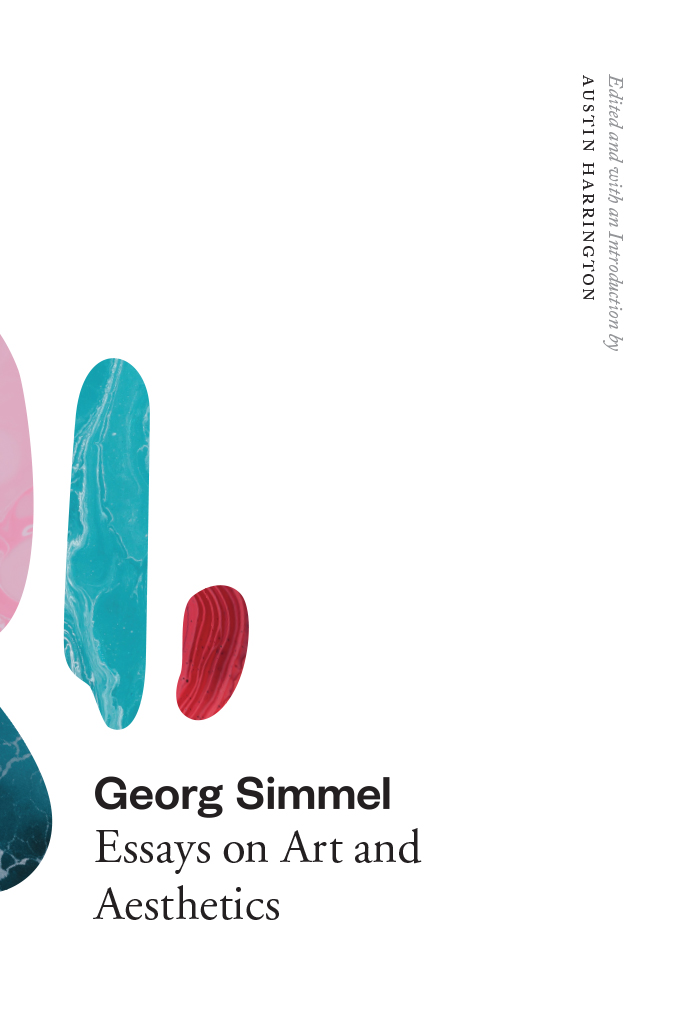
EDITED AND WITH AN INTRODUCTION BY AUSTIN HARRINGTON
The University of Chicago Press
Chicago and London
The University of Chicago Press, Chicago 60637
The University of Chicago Press, Ltd., London
2020 by The University of Chicago
All rights reserved. No part of this book may be used or reproduced in any manner whatsoever without written permission, except in the case of brief quotations in critical articles and reviews. For more information, contact the University of Chicago Press, 1427 E. 60th St., Chicago, IL 60637.
Published 2020
Printed in the United States of America
29 28 27 26 25 24 23 22 21 20 1 2 3 4 5
ISBN-13: 978-0-226-62093-0 (cloth)
ISBN-13: 978-0-226-62109-8 (paper)
ISBN-13: 978-0-226-62112-8 (e-book)
DOI: https://doi.org/10.7208/chicago/9780226621128.001.0001
Sociological Aesthetics, On Aesthetic Quantities, On the Third Dimension in Art, and The Dramatic Actor and Realilty reprinted with permission of the publisher from Georg Simmel: The Conflict in Modern Culture and Other Essays (New York: Teachers College Press). 1968 Teachers College Press, Columbia University. All rights reserved.
The Handle and The Aesthetic Significance of the Face reprinted with permission of the publisher from George Simmel, 18581918: A Collection of Essays, with Translations and a Bibliography, ed. Kurt H. Wolff (Columbus: Ohio State University Press, 1959).
Goethe and the Creative Life reprinted with permission of the publisher from The Anthem Companion to Georg Simmel, ed. Thomas Kemple and Olli Pyyhtinen (London: Anthem Press/Wimbeldon Publishing, 2016).
The following essays are reproduced with permission of the publisher from Theory, Culture and Society: On Art Exhibitions, 32, no. 1 (January 2015): 8792; The Picture Frame: An Aesthetic Study, 11, no. 1 (February 1994): 1117; Individualism in Art, 24, nos. 78 (December 2007): 7176; Germanic and Classical Romanic Style, 24, nos. 78 (December 2007): 5358; and The Philosophy of Landscape, 24, nos. 78 (December 2007): 2029. 1994, 2007, 2017 SAGE Publications.
Library of Congress Cataloging-in-Publication Data
Names: Simmel, Georg, 18581918, author. | Harrington, Austin, 1970 translator, editor.
Title: Essays on art and aesthetics / Georg Simmel ; edited and with an introduction by Austin Harrington.
Description: Chicago ; London : The University of Chicago Press, 2020. | Translated from German. | Includes bibliographical references and index.
Identifiers: LCCN 2020001532 | ISBN 9780226620930 (cloth) | ISBN 9780226621098 (paperback) | ISBN 9780226621128 (ebook)
Subjects: LCSH: Aesthetics. | ArtsPhilosophy. | ArtPhilosophy.
Classification: LCC B3329.S62 .E54 2020 BH21 | DDC 111/.85dc23
LC record available at https://lccn.loc.gov/2020001532
 This paper meets the requirements of ANSI / NISO Z39.48-1992 (Permanence of Paper).
This paper meets the requirements of ANSI / NISO Z39.48-1992 (Permanence of Paper).
Georg Simmel (18581918) is best known today as the author of several groundbreaking studies in modern European social criticism and philosophy. Many readers will know him for works such as The Philosophy of Money (1900) or Sociology: Inquiries into the Construction of Social Forms (1908), and for essays such as The Metropolis and Mental Life, The Stranger, and The Concept and Tragedy of Culture. Yet less well appreciated are many highly original writings by Simmel on movements and personalities of the arts in European cultural history from the Middle Ages to the early twentieth century. These include book-length studies of Goethe and Rembrandt, as well as a plethora of essays on figures from Michelangelo and Leonardo da Vinci to Auguste Rodin, on forms and media of art, on philosophies of the arts after Kant and Schopenhauer, and on sociological circumstances of the arts in modern culture and economy.
Scholars of Simmels writings have long recognized the importance of art and aesthetics to Simmels vision of modern forms of society. Commentators have long emphasized that artistic and aesthetic images of the world form at once an object of Simmels concerns and a mediumperhaps even the mediumof his entire style and practice of investigation. Constantly, Simmel writes in a way that elaborates symbols, metaphors, tropes, and analogies as experimental clues to an illumination of the deep structures of mind and behavior that preoccupy him. Yet the distinctively plastic, relational, even in some respects diffuse, character of his writing, combined with the highly dispersed fate of his publications after his death, has meant that for many years, the significance of art and aesthetics in his oeuvre has been difficult to determine in the overview.
Himself very aware of the scattered and incomplete nature of his writings on art, Simmel had at many stages sought to produce some form of integrated volume on the field. Repeatedly, he spoke to friends of his plans for a major study of the Philosophie der Kunst, as he termed it. Writing to the philosopher Heinrich Rickert in May 1901, he described the project as a burning and dominant interest of his for some years. This declaration he reiterated to Rickert in April 1902, and again in 1905, and yet again in 1907 to his son Hans. On 26 September 1918, Simmel died, barely six weeks before the end of the Great Warleaving behind a vast array of texts, many of them largely unknown before work began in the 1980s on a collected edition of his writings, the Georg-Simmel-Gesamtausgabe, published in Germany by Suhrkamp Verlag (19892014).
This collection of Simmels essays presents a thematic arrangement of his writings. It follows a format designed to suggest the shape of the project he might have sought to develop in his lifetime. Approximately a third of the volumes content exists in English translations already, but the pieces are dispersed over journal issues and edited collections dating back to the 1960s, and some are not easily accessible. Those earlier translations, slightly edited, are here supplemented with fresh translations of the remaining two-thirds of Simmels texts. A thematic arrangement has been chosen to highlight Simmels prevailing concerns and to honor the priority he almost certainly would have given to substantive clusters over simple linear chronology.
Readers wholly new to these writings, however, may appreciate first of all an account of the complex threads underlying the essays, few of which are likely to be clear from any one item read in isolationor perhaps even two or three items. Thus this extended introduction begins by outlining the circumstances of Simmels involvement with artistic currents of his time and the concepts he brings to bear in his analyses (1, 2). Subsequent sections explain the key ideas driving his picture of formative events in European art history, together with the importance he attaches to urbanization, industrialization, and individualization as dynamics in the shaping of modern structures of culture (3, 4, 5). Four further sections elucidate Simmels statements on problems of autonomy, representation, and expression in art and on diverse forms, genres, and styles of modern art (6, 7, 8, 9). A final section surveys Simmels impact in twentieth- and twenty-first-century art theory and his import for debate today (10).
In contrast to his great contemporary in German sociology, Max Weber, relatively little is known about Simmels personal circumstances and the direct sources of inspiration for his writings. Rarely a user of footnotes, Simmel seldom offers clues to the contexts, motives, and origins of his ideas, and much of what was almost certainly a voluminous correspondence with friends and associates, which might have revealed these impulses, is today lost. In the late 1880s, through his Berlin friend Sabine Lepsius, daughter of Gustav Graef and wife of Reinhold Lepsiusall three paintersSimmel met his future wife, Gertrud Kinel (herself a painter), and, together, the couple played host to and attended numerous salons of artistic figures throughout the following two decades.
Next pageFont size:
Interval:
Bookmark:
Similar books «Essays on Art and Aesthetics»
Look at similar books to Essays on Art and Aesthetics. We have selected literature similar in name and meaning in the hope of providing readers with more options to find new, interesting, not yet read works.
Discussion, reviews of the book Essays on Art and Aesthetics and just readers' own opinions. Leave your comments, write what you think about the work, its meaning or the main characters. Specify what exactly you liked and what you didn't like, and why you think so.

